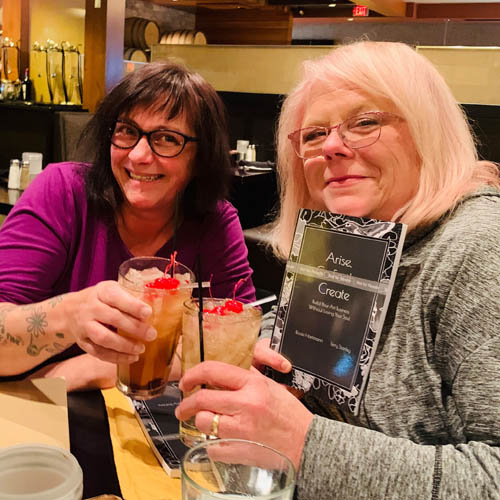by Bob Bahr
It’s not quite a self-help book, not quite a memoir, not quite a how-to. Instead, Arise, Go Forth, Create: Build Your Art Business Without Losing Your Soul reads like a conversation over coffee (and/or possibly whiskey) with your favorite aunts about where your art career is and where it could go. The tone is straightforward and informal. The approach is unflinchingly open and honest. And you would be forgiven if at times you heard Stanley’s voice in her head as she offers her trademark no-nonsense, Wisconsin-strong advice.
Consider Stanley’s words on getting some killer clothes to wear for a presentation. “Find an outfit that you absolutely love and imbue it with special powers,” Stanley writes. “When you don the outfit, you will be magically transformed into the perfect marketing tool for your work. You will not fear approaching strangers and introducing yourself. You will feel competent and powerful. You will sparkle like a brand-new diamond, and you will speak of your work with eloquence and humor. YOU ARE A STAR in that outfit! The magic is already there, you just have to access it.”
Stanley is a painter and an art industry veteran who launched an art school and at least one art competition for the Jack Richeson Company, and she has made sure that art materials are available for purchase at nearly every SKB Dubois workshop. Her writing partner, Rosie Hartmann, is a photographer, multimedia artist, and marketing guru. Together they offer tough love and calm assurance on the art life. “This book is meant to push, educate, and make you laugh on occasion,” Hartmann writes in the book, which is available via this website.
The writing style is quite lively; it’s unlikely you will put this book down out of boredom or because you need a break. Nevertheless, it is clearly designed to be read in small chunks, its wisdom considered in the off-hours before you pick it up again.
Hartmann and Stanley cover a lot of ground, but some nuggets will inevitably stick with you. Consider Stanley’s comment in the section on critiques: “Critique is an opportunity to learn, and that is ALWAYS valuable. Critique can bruise but won’t break you. It’s like being pruned: You may lose a leaf now, but you’ll grow back fuller.” Or Hartmann’s words on dealing with the insecurity that art-making can create in an artist: “Fear is a basic component of art. We live on the fringes of anarchy, self-destruction, egomania, and the desire to take over and reshape the world. News flash: That is not most people. In fact, it’s a relatively low few.”
The images in the book are in black & white and are not particularly important to the text except to break it up a little bit. The duo plays with the linear nature of books by offering one point of view, then having the other writer respond—regardless of whether they agree or disagree with the first approach to the topic. In other words, Terry may say one thing, then a page later, Rosie may agree, disagree, or take a totally different approach. Headings in the book are unpredictable and sometimes contradictory, always for a purpose, even if it seems mostly to inject some levity. Consider a major heading in the book that reads, “It’s Not About the Money.” On the next page, the subhead reads, “Terry Pontificates on the Bullshit of It’s Not About the Money.” Stanley then states that, “Receiving payment validates your work in a universally accepted manner.” Rosie adds, “Each work has two parts of its life: the creating part and the commodity part. Yup, I said it. Art is a commodity. We rage at art being treated as a commodity, yet we want the dollars to come to us from our work. That is not balanced. That is, well, hypocrisy. Sorry, it is.”
The book is indeed funny. Consider Stanley’s comments on the dreaded artist’s statement. “There exists some excellent Artist’s Statements, although they’re as rare as pangolins. … The most common statements that incite prolonged, involuntary eye-rolling in me are the ones that try way too hard to be cerebral. You are NOT required to use five-syllable words, reference the Law of Quadratic Reciprocity, or delve into the psyche of unicorns.”
It’s not all a big joke. As many SKBers know, Stanley has a good eye and a good head for what a painting needs. Hartmann will be something of a revelation to SKBers, and here’s hoping she attends the next SKB Artist Rendezvous & Workshop. “Art has a life of its own,” Hartmann asserts in one spot in the book. “Once it is finished, it wants more; being made is not enough. (Let me add the caveat that for some artwork, being created is enough—can you tell the difference?) The hard truth is art itself has a job to do. It could be one of many jobs—i.e., adding beauty to the world, spreading a message, offering a quiet reprieve, or creating disturbing, thoughtful, or fruitful conversations. Your art, when it is at its best is ALIVE.”
The two friends simultaneously offer advice like sages and poke fun at the very notion of an art biz guru. They know what’s real in all of this. “Applying concrete principles and practices to something as ephemeral as your creative being and process is something like sculpting oatmeal,” they write. “Can it even be done? Well, sure, but you may have to adjust both your methods and your expectations.”
Business acumen is no substitute for quality in one’s art. Hartmann and Stanley know this. “Inside all of the things Terry and I have to say, getting in the studio and making art IS the most important thing.” But reading this book and picking the advice that’s right for you can make all the rest of your art life much more fruitful. Ω
Get more info and buy Arise, Go Forth, Create here.




